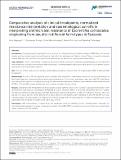| dc.description.abstract | Introduction. Existing breakpoint guidelines are not optimal for interpreting antimicrobial resistance (AMR) data from animal
studies and low-income countries, and therefore their utility for analysing such data is limited. There is a need to integrate
diverse data sets, such as those from low-income populations and animals, to improve data interpretation.
Gap statement. There is very limited research on the relative merits of clinical breakpoints, epidemiological cut-offs (ECOFFs)
and normalized resistance interpretation (NRI) breakpoints in interpreting microbiological data, particularly in animal studies
and studies from low-income countries.
Aim. The aim of this study was to compare antimicrobial resistance in Escherichia coli isolates using ECOFFs, CLSI and NRI
breakpoints.
Methodology. A total of 59 non-repetitive poultry isolates were selected for investigation based on lactose fermentation on
MacConkey agar and subsequent identification and confirmation as E. coli using chromogenic agar and uidA PCR. Kirby Bauer
disc diffusion was used for susceptibility testing. For each antimicrobial agent, inhibition zone diameters were measured, and
ECOFFs, CLSI and NRI bespoke breakpoints were used for resistance interpretation.
Results. According to the interpretation of all breakpoints except ECOFFs, tetracycline resistance was significantly higher (TET)
(67.8 –69.5 %), than those for ciprofloxacin (CIPRO) (18.6 –32.2 %), imipenem (IMI) (3.4 –35 %) and ceftazidime (CEF) (1.7 –45.8 %).
Prevalence estimates of AMR using CLSI and NRI bespoke breakpoints did not differ for CEF (1.7 % CB and 1.7 % COWT
), IMI (3.4 %
CB and 4.0 % COWT
) and TET (67.8 % CB and 69.5 % COWT
). However, with ECOFFs, AMR estimates for CEF, IMI and CIP were sig-
nificantly higher (45.8, 35.6 and 64.4 %, respectively; P<0.05). Across all the three breakpoints, resistance to ciprofloxacin varied
significantly (32.2 % CB, 64.4 % ECOFFs and 18.6 % COWT
, P<0.05).
Conclusion. AMR interpretation is influenced by the breakpoint used, necessitating further standardization, especially for
microbiological breakpoints, in order to harmonize outputs. The AMR ECOFF estimates in the present study were significantly
higher compared to CLSI and NRI. | en_US |

